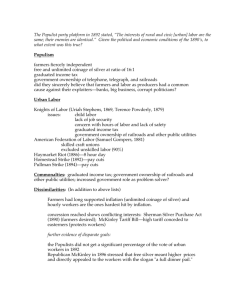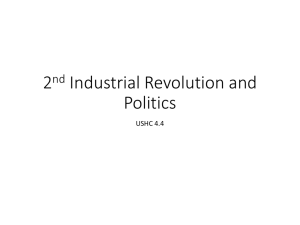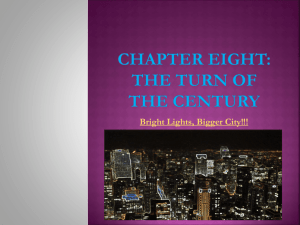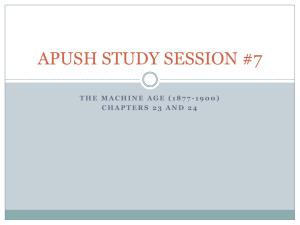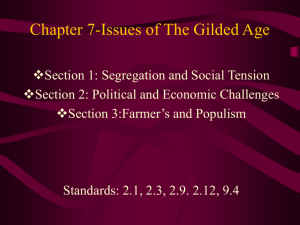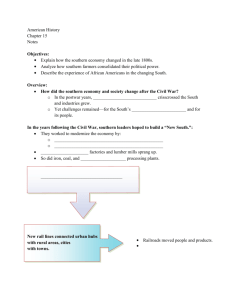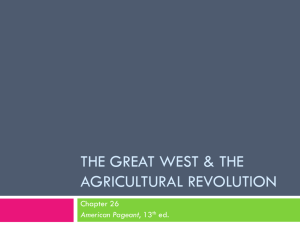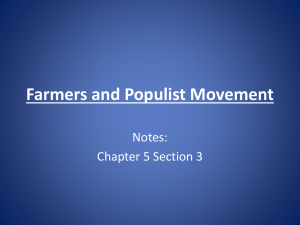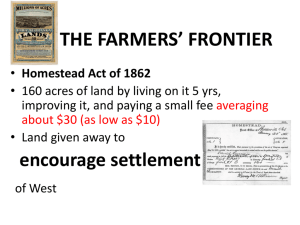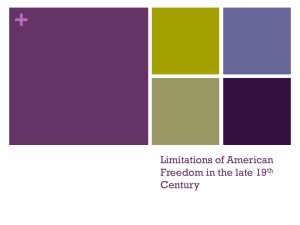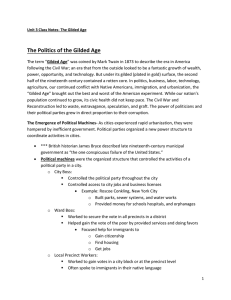Life at the Turn of the Century Notes
advertisement
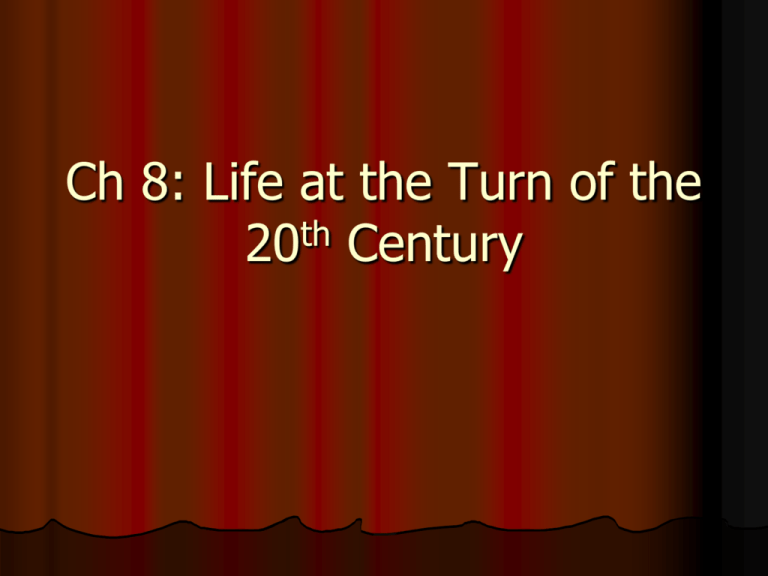
Ch 8: Life at the Turn of the th 20 Century Science and Urban Life Cities in every industrial area of the country expanded both outward and upward By the turn of the 20th century, 4 out of 10 people lived in the cities. Electric Transit Allowed cities to spread outward Electric “Trolley Cars” ran from outlying neighborhoods to downtown offices and department stores. Some cities like Chicago elevated their trains Other cities like New York moved them underground. Urban Planning City planners sought to restore a measure of serenity to the environment. In 1857 Frederick Olmsted drew up the plans for Central Park in New York City. Daniel Burnham turned Chicago into a beautiful city with parks and sandy lakefront beaches. New Technologies Advances in printing increased the literacy rate to 90% by 1890. December 17, 1903 the Wright Brothers flew the first engine powered plane. George Eastman created film for use in cameras and created the company “Kodak” to bring picture taking to the masses. Expanding Public Education Most states had established public schools by the Civil War; however, many school-aged children received no formal education Between 1865 & 1895- state laws were passed requiring 12 to 16 weeks annually of school attendance by students between 8 and 14. They emphasized reading, writing and arithmetic. Kindergarten became popular during this time. It was generally created as a place where working mothers could leave their kids. Growth of High Schools “Providing ladders upon which the aspiring can rise” Andrew Carnegie In 1900, more than ½ million students attended high school. Subjects began to expand to science, civics and social studies. African Americans were mostly excluded from public secondary education. Immigrants were encouraged to go to school. Helped them to become “Americanized.” Catholic Schools were formed because they were concerned about the Protestant King James version of the bible. Higher Education Colleges begin to Boom. 1880-1920- College enrollments quadrupled. Law and Medical schools established. Began using the high school diploma for college entrance requirements. With the help of the Freedman’s Bureau, African Americans founded Howard University and Atlanta (Clark) and Fisk University. Booker T Washington Was born as a slave. Graduated from Virginia Hampton Institute. He said that racism would end once blacks acquired the useful labor skills and proved their economic value to society. R.C. Ogden, Senator Taft, Booker T. Washington, and Andrew Carnegie n.d. Library of Congress 1881- started the Tuskegee Normal and Industrial Institute in Alabama. WEB DuBois 1st African American to receive a doctorate from Harvard in 1895. He founded the Niagara Movement, which stated that blacks should seek a liberal arts education so that the African American community would have well educated leaders W.E.B. DUBOIS African Americans Legal Discrimination system of legal policies of racial discrimination and tried to find ways to weaken blacks political power. literacy test to vote. Pay the Poll Tax to vote Grandfather clause for the whites Passes racial segregation laws (Jim Crow Laws) Plessy v. Feguson 1896 South Carolina ruled that the separation of races in public accommodations was legal and didn’t violate the 14th amendment. It established separate but equal as long as it maintained separate facilities as long as they were provided equal service. Permitted legalized racial segregation for almost 60 years. Discrimination in the North 1900- Many blacks moved to the North in search for better paying jobs and social equality. Big discrimination in the North also. Found themselves forced into segregated neighborhoods. There was also discrimination on the job. Mexican workers In the late 1800’s the railroads hired more Mexicans than members of any other ethnic group. They were used to the hot dry climate. Railroads made them work for less money than any other ethnic group. The Dawn of Mass Culture Middle class Americans from all over the country shared experiences as new leisure activities, nationwide advertising campaigns, and the rise of consumer culture began to level regional differences. Amusement Parks: Coney Island was built in 1884. One of the first roller coasters was located here. 1st Ferris Wheel of the world was at the Columbian Exposition in Chicago in 1893. Baseball 1845, Alexander J Cartwright organized a club in New York City. Five years later, 50 baseball clubs had been formed. 1869- the Cincinnati Red Stockings were touring the country playing exhibition games. This lead to the national league in 1876 and the American League in 1900. First World Series was held in 1903 between the Boston Pilgrims and the Pittsburgh Pirates. African Americans, excluded from the white leagues, formed their own league called the Negro American League and the Negro National League. Shopping Earliest form of a shopping center opened in 1890 in Cleveland, Ohio. Marshall Fields was the first department store in Chicago. He found that paying attention to female customers, business would increase. Woolworth’s was the first “chain” store. Catalogs became popularMontgomery Wards and Sears were one of the first to have the catalogs. The Morrill Act of 1862 and 1890 gave federal land to the states to help finance agricultural colleges. When crop prices were high, farmers could repay their loans. When crop prices fell, farmers grew more, which caused prices to fall even more Railroads charged Western farmers a higher fee than Eastern farmers farmers needed to organize. In 1867, Oliver Hudson Kelley started the Grange. Members learned how to Support political candidates, create legislation to regulate railroads, fight the power of the banks. Leaders of the Farmer’s alliance created the Populist Party, in 1892. The Populist Party demanded reforms: to reduce debt from farmers and laborers give the people a greater voice in their government. • The Populists' share the platform of the Democratic Party believe: The government is responsible for reforming social injustices. The Democrats and populist’s favored bimetallism, either gold or silver in exchange for paper currency or checks. The Republican favored the gold standard –backing dollars solely with gold. Republican Party William McKinley for president. The Democratic Party nominated William Jennings Bryan • • The voters of the industrial Middle West, with their fear of inflation, brought McKinley into office. With McKinley's election, Populism collapsed, burying the hopes of the farmers..
